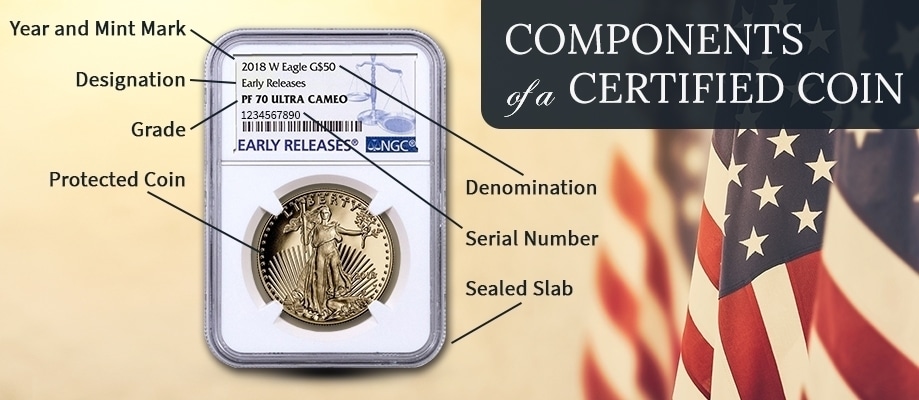Investment Guide
INVESTMENT GUIDE
Your Guide to Investing in Precious Metals
INVESTMENT GUIDE
- RESOURCES
Why Buy
Precious metals have an intrinsic value. This means they carry value far beyond whatever denomination is stamped on the coin you see. All of our precious metals have uses in the industrial and technological sectors. All are used to make jewelry. This means that, unlike many stocks, the worth of these assets will never be zero.
Gold and silver have the weight of history behind them. Both have been used as a medium of exchange for centuries.
Both of these facts make precious metals an excellent hedge against inflation or economic disaster. But once you’re done protecting yourself against the risks of fiat currency, what do you do next? What’s the best way to invest?
Before choosing any coin you must consider your investment goals.
Setting Your Investment Goals
Ask yourself these questions:
- Do you want to grow your value over time with a safe, stable investment?
- Do you want the chance for aggressive growth and large returns?
- Do you intend to use this investment to retire?
- How liquid do you need this investment to be?
- How much will you purchase at a time?
The answers to each of these questions will help you put together a sound, solid strategy.
Precious Metal Coins vs. Numismatic Coins
Gold bullion coins are the safest investment. Gold bullion has consistently grown its value over ten and twenty year periods. If you have the patience to hold on to it that long it can grow your wealth by leaps and bounds, especially if you invest consistently over time.
But the amount of growth will not be staggering. For example, if you bought an ounce of gold 20 years ago you could have done so for $450. Today, you could sell it for a little under $1400. That’s an impressive level of growth, but not an aggressive one.
Numismatic coins have the potential to deliver value far beyond the value of the coin’s weight. For example, there are silver coins that are worth $15 by weight and $50,000 as a collectible.
But numismatic coins are also a little riskier. If you buy them for more than the value of the gold inside there is no guarantee they’ll ever be worth more. They will rarely be worth less, but it can happen. Of course, they are still not as risky as stocks and bonds, as they will always maintain their intrinsic value, so long as the numismatic coins you purchase are made of gold or silver.
If you invest in numismatic coins you’ll want to pay attention to the coin’s condition, or grade. You’ll also want to familiarize yourself with what collectors are looking for, and what has performed well in the past. Finally, you’ll want to educate yourself on what it takes to care for these coins. If you damage them or devalue them you’ll never see the kinds of return on investment that you would otherwise.
Coins vs. Bars vs. Rounds
The most liquid coins are bullion from recognized countries such as the United States, Canada, Australia, and Britain. When you purchase an American Gold Eagle you are getting the US government’s guarantee that the gold is at its correct weight and is a genuine piece. Most investors will want to stick to bullion coins. Certain bullion coins also have the potential to become numismatic coins later.
Bars are difficult to store. Usually, investors who are purchasing huge quantities of precious metals opt for these.
Rounds are gold coins printed and minted by private concerns. They aren’t backed by any government. As long as you’re getting them from a reputable source they’re a reasonable investment. Gold is gold, no matter what’s stamped on the surface of it. However, these coins are not quite as liquid as bullion coins as many are reluctant to purchase them without a government guarantee.
Physical Ownership vs. Precious Metal IRAs
Many investors enjoy having gold and silver to hold in their hands. Physical ownership is the most private form of investment, and it’s one of the most popular. Investing this way keeps your portfolio under control and makes it as liquid as possible. If you need to, you can always sell a few coins to get your hands on some quick cash.
But those who want to use their investment to retire might want to look into a precious metal IRA. When you purchase a coin for an IRA it is held for you off-site. A portfolio manager will purchase and track the performance of your investments for you. In the meantime, you can use the IRA just as you’d use any retirement account. If retiring on gold and silver is your goal, you should put at least a portion of your investment into this type of fund.
Choosing the Right Metals
If you want a safe, reliable investment, choose gold. It’s the most consistent performer, and its value remains high no matter what.
If you want an investment with far more potential because of its scarcity and actual use, try palladium or platinum. Both are currently in demand because of their industrial applications, and because they are so difficult to find and mine.
If you only have a little to invest, go for silver! Almost anyone can invest in this precious metal. Though the prices are more volatile, they’re also more accessible. One silver coin costs less than a pizza. If you can hold on to silver long enough you’ll see significant returns. And purchasing one or two coins a month over the course of years could help you build a very nice nest egg.
Ultimately, we encourage all our customers to diversify. It’s a good idea to have a mix of bullion coins, numismatic coins, and all four precious metals in your portfolio. It doesn’t hurt to mix your investments with other hard assets like real estate, either. Diversification protects you against sudden losses and shifts in the market which could make your investment performance less than ideal.
Not sure where to start? Need a little direction? Talk to one of our precious metal specialists today.
Gold
The U.S. dollar is a “fiat currency”, meaning it is not backed by precious metals, only the trust people have in our money, the government, and the banking system. Fiat currency has a 100% failure rate – ALL fiat currencies throughout history have failed. That is an incredibly disturbing statistic, especially for those looking to provide for their families and their futures.
Gold has always maintained its value over long periods of time. Statistics and charts over the last 20 and 30 years show a clear and obvious steady increase in prices.
Certified Coins
Certified coins are an excellent choice for investors and collectors alike, as they ensure the coin within its protected slab is authentic and has not been tampered with. Additionally, certified coins have traditionally far outperformed their uncertified, or raw, counterparts.
Components of a Certified Coin
Certified coins contain a wealth of information on the labels sealed within their slabs. A wise investor is an educated investor. Knowing the components of certified coins can help in making the right decisions for your portfolio.

Year and Mint Mark
Designation
This is the special designation of a particular coin, if it has one. Coin grading services typically use this area to denote “Early Release”, “First Strike” or other designations that may apply to the particular coin in question. The coin in our example above shows “Early Release”, indicating this coin was received by NGC (the coin grading service for this coin) within 30 days of its release.Grade
This is the grade a coin is given by the grading service. In our example coin above, the coin is graded as “PF70 Ultra Cameo”. This means the coin is a Proof coin and has been given a grade of 70. In addition, NGC has noted this coin to be “Ultra Cameo”, referring to the amount of frost present in the design elements. Coins graded by NGC and PCGS are graded based on the Sheldon Grading Scale as shown below.Protected Coin
Once graded, the coin is placed within its slab before sealing and is protected from the elements to prevent damage and/or tarnishingDenomination
This is the nominal face value given to a particular coin by its producing mint. In our example, the denomination is $50.Serial Number
This is the unique number given to a coin once it has been certified by the grading service. In our coin above, we’ve used “1234567890” as an example.Sealed Slab
Once graded and the coin placed within its container, or “slab” as referred to in the industry, the slab itself is sealed to protect it from the elements and to further guarantee that the graded coin within has not been tampered with.Certification Grading Scale
The Sheldon Grading Scale, created by William Herbert Sheldon, Jr., is the 70 point coin grading scale used by coin grading services, such as NGC and PCGS, in the numismatic assessment of a coin’s quality. It is considered the industry standard in coin grade definitions.
60
Unattractive, dull or washed-out, mint luster typify this coin. There may be many large detracting contact marks (bag nicks), or damage spots, but absolutely no trace of wear. There could be a heavy concentration of hairlines (minute scratches to a coin’s surface), or unattractive large areas of scuff-marks. Rim nicks may be present, and eye appeal is very poor. Copper coins may be dark, dull and spotted.
61
Mint luster may be diminished or noticeably impaired, and the surface has clusters of small contact marks throughout. Hairlines could be very noticeable. Scuff-marks may show as unattractive patches on large areas or major features. Small rim nicks, striking or planchet defects may show, and the quality may be noticeably poor. Eye appeal is unattractive. Copper pieces will be generally dull, dark and possibly spotted.
62
Impaired or dull luster may be evident. Clusters of small marks may be present throughout with a few large marks or bag nicks in prime focal areas. Hairlines may be very noticeable. Large unattractive scuff-marks might be seen on major features. The strike, rim and planchet quality may be noticeably below average. Overall eye-appeal is generally acceptable. Copper coins will show a diminished color and tone.
63
Mint luster may be slightly impaired. Numerous small contact marks, and a few scattered, heavy marks may be seen. Small hairlines are visible without magnification. Several detracting scuff marks or defects may be present throughout the design or in the fields. The general quality is average, but overall, the coin is rather attractive. Copper pieces may be darkened or dull.
64
Coin has good, overall average luster and even strike for the type. Several small contact marks in groups, as well as one or two moderately heavy marks may be present. One or two small patches of hairlines may show under low, (3-4x) magnification. Noticeable, light, scuff marks or defects may be seen within the design or in the field. Attractive overall quality with a pleasing eye appeal. Copper coins may be slightly dull.
65
Coin shows an attractive high quality of luster and strike for the date and originating mint. A few, small, scattered, contact marks, or two larger marks may be present, and one or two small patches of hairlines may show under (5x+) magnification. Noticeable, light, scuff marks may show on the highest points of the design features. Overall quality is above average and eye appeal is very pleasing. Copper coins have full luster with original or darkened color.
66
Coin has above average quality of strike and full original mint luster, with no more than two or three minor, but noticeable, contact marks. A few very light hairlines may show under (6x+) magnification, or there may be one or two light, scuff marks showing on frosted surfaces or in the field. The eye appeal must be above average and very pleasing for the date and originating mint. Copper coins display full original or lightly toned color.
67
Coin has a sharp strike with full, original luster, May have three or four very small contact marks and a single, more noticeable, but not detracting mark. On comparable coins, one or two small single hairlines may show under (6x+) magnification, or one or two partially hidden scuff marks or flaws may be present. Eye appeal is exceptional. Copper coins have lustrous original color.
68
Coin has a sharp strike with full original luster, with no more than four, lightly-scattered, contact marks or flaws. No hairlines or scuff marks show. Copper coins have lustrous original color. Eye appeal is exceptional.
69
Coin has a sharp strike with full original luster, with no more than two small non-detracting contact marks or flaws. No hairlines or scuff marks are visible. Eye appeal is exceptional.
70
The perfect coin, as minted. Has no trace of wear, handling, scratches or contact with other coins from a (5x) magnification. Coins in this grade are almost non-existent in older coins with very few examples known. Copper coins are bright with full original color and luster. Eye appeal is exceptional.







